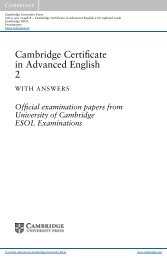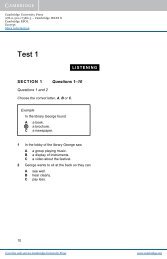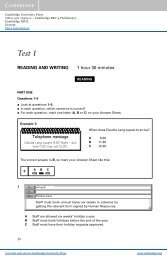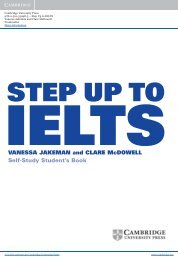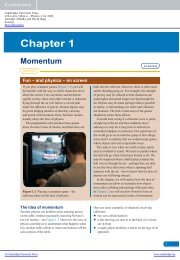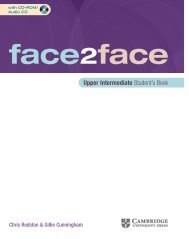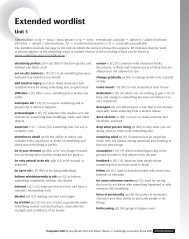Skills for Study Level 2 Teacher's Book - Cambridge University Press
Skills for Study Level 2 Teacher's Book - Cambridge University Press
Skills for Study Level 2 Teacher's Book - Cambridge University Press
You also want an ePaper? Increase the reach of your titles
YUMPU automatically turns print PDFs into web optimized ePapers that Google loves.
4.33dSuggested answersClaim 1 is rather weak, as it’s based only on anecdotal evidence. However, thespeaker is certain about it, as they say there is ‘clearly’ a difference in notionsof beauty between cultures.Claim 2 is slightly stronger, as it gives evidence from a study in support.However, the speaker says that it would be dangerous to conclude just fromthis one study that definitions of beauty did vary in this way, so they seemslightly less certain about this.3e Students decide their own response to the claims.3f Student discussionUnit Task: Designing buildings <strong>for</strong> human needsa & b Group discussioncAnswers4.4Main idea of the talk: That the physical features of a building (whetherarchitecture or indoor design elements) can have significant impacts on theenvironment and on the people who live and work within them. Architects,planners and designers should take these impacts into account.Sub-topic:EnvironmentalconsiderationsAffective factorsPractical factorsClaim:There are innovative techniques <strong>for</strong> designingbuildings to be more environmentally friendly (e.g.less energy hungry).The speaker seems certain of this claim, butoffers no evidence in support of it.The physical features of a building have ‘affective’qualities (they can impact the mood, emotions,psychological state, etc. of the occupants). Thisincludes effects from things like lighting, colourschemes, furnishings and building materials, etc.The speaker claims that a number of studies haveestablished a link, but that conclusive evidenceof their impacts is ‘hard to come by’. The speakerdoes make a claim <strong>for</strong> the benefits of indoorplants, citing a study by Shibata and Suzuki,which found that indoor plants helped women inparticular do well on cognitive tests. However, thespeaker says that the link is ‘possible’, so she isnot claiming it is absolutely certain.Claims that studies in ergonomics can help toimprove ease of use <strong>for</strong> workspaces, and thatthis can improve productivity and reduce injury.However, no specific evidence is offered. Thespeaker, nonetheless, seems certain of the valueof this type of research, and its importance ingood building design.Unit 4 Part A ∙ Understanding spoken in<strong>for</strong>mation 109



